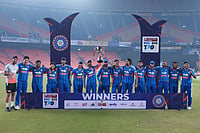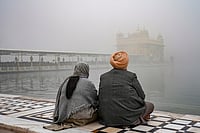Ganga is a critical figure in mythology because she is the personification of the river Ganga. The river Ganga is important because it is a life-giving and incredibly important source of water for a significant half of the country. It is also one of the most important religious and sacred rivers in India. It is a critical part of the funerary rituals of many Hindus as the goddess is supposed to flow through the three realms and help carry the ashes of the dead to the heavens.
Where are her depictions found? She is not seen in museums that often because she appears in temple doorways and most depictions of her still remain in-situ. There are a few that do make their way to museums, either because they are in a different medium than the stone sculptures that usually adorn temples or because they have been extracted from temples. The varying mediums and representations of Ganga make for an interesting adventure in locating her in museums.
Do you know what the abhaya mudra translates to on a stone figure? Or that the makara changes from sculpture to sculpture, having no one representation? Or that the goddess Ganga is usually paired with Yamuna when portrayed in temple doorways? These are all questions of iconography that curators and scholars spend their whole lives uncovering. So how can a layman approach these works of art and succeed in identifying discrete icons/images among them, such as the representation of Ganga?
The Story of Ganga
Let’s start with her story. Ganga and her story appear in the Puranas, the Ramayana and the Mahabharata. Tales of her birth speak of her being the daughter of Himavat (or the personification of the Himalayas). She is also known as the sister of Parvati who is also a daughter of Himavat.
According to the legends, Ganga was brought forth from the heavens because of the penance that the Sage Bhagirath performed for the salvation of his ancestors whose spirits roamed the Earth because of a curse. Through penance and prayer, Bhagirath got Brahma to
agree to send Ganga down to Earth and travel to the nether regions, allowing the souls of his ancestors to rise to the heavens. Ganga, unhappy at being ordered to go to Earth, found this demand insulting. In response, she raged and threatened to sweep the earth
away underwater. Bhagirath, alarmed, prayed to Shiva for help.
On her descent from the heavens, Ganga fell on Shiva’s head who trapped her within his locks and calmed her descent. Rather than flooding the Earth and destroying it, he let her descend in small streams. Shiva’s touch further sanctifies Ganga, and she extends into three realms to purify souls in each realm. She traverses through Swarga (heaven), Prithvi (Earth) and Patala (netherworld) and purifies the souls in all the realms.
To read more: https://archive.org/details/Ganga-Comic/mode/2up?view=theater

Iconography
Understanding who Ganga is, helps us understand how she is represented through art. Additionally, understanding her history helps identify images that reference her without explicitly depicting her. A rock-cut panel in Mahabalipuram, in Tamil Nadu, tells the story of Bhagirath’s penance. The panel features a sage standing on one foot in vrksasana (or the tree pose). Nagas, who live in Patala and wait to receive Ganga as she travels to the nether realm, are also represented in the image. They are associated with Ganga as they have the theme of water in common. Therefore, while this image doesn’t depict Ganga herself, it tells her story and is an important part of the imagery that makes up her story across history.
Found most often at the base of doorways, the stone figurines of Ganga from early history, have some interesting features. She is usually
depicted at the bottom of the frame of a sculpted stone doorway and very often Yamuna is depicted parallel to her. There is a trick to distinguishing the two: you have to look for their vahanas. Vahanas are the vehicles upon which the goddesses travel. Both have different ones; the Makara (or crocodile) for Ganga and the kurma (or tortoise) for Yamuna.

As seen in the images below, the makara can be found in various different styles; some more floral like from a Ganga sculpture from Ellora;
others with clearly marked scales like the makara from the temple in Raipur. The designs change depending on region, time period and
artistic medium.


Besides the vahanas, Ganga can be identified via other features that are often associated with her and all stem from her stories and myths. She is usually depicted with four arms, each of which holds a different item that is significant to her. Some of these artefacts are a jar or kalash of amrita, rosary, lotus, shivlinga and hands in varada mudra. This particular combination of features shows up in the depiction of Ganga in the Maha Virat-rupa which is essentially the form of a deity normally seen in the Bhagvada Gita that is an omnipresent and all-powerful version of that particular deity.
In other depictions, she is seen holding a kalash or ghata and a lotus while two of her hands are in varada or abhaya mudra. Another depiction shows her holding a kalash, trident, shivlinga, and her hand in the Varada mudra. In several of these depictions, she is also shown with attendants holding up a chhatra.
Later depictions, mostly seen in paintings originating from the Kalighat school in Bengal, show Ganga holding a shankha, chakra, lotus, and her hand in the abhaya mudra. The kalash is normally shown pointing down, releasing the waters of Ganga to sanctify the masses.
This is all to say that there are a variety of combinations in which Ganga can be depicted based on the region, time period and art style. The significance of each of the symbols that Ganga is depicted with is listed below, so you can understand more clearly what the artist was trying to depict with a particular combination of symbols.
● Lotus: This flower represents beauty, prosperity and fertility. It also represents spiritual awakening and enlightenment.
● Rosary: It represents the cyclical nature of life
● Shivalinga: This is a phallic representation of Shiva and is an emblem of generative power
● Hands in varada mudra: The varada mudra is when the right hand is held out with all the fingers pointing downwards and with the palm facing outwards. This is the gesture that symbolizes the dispensing of a boon.
● Hands in abhaya mudra: The abhaya mudra is when the right hand is held upright, and the palm is facing outwards. It is a gesture of reassurance and safety that dispels fear and accords divine protection and bliss.
● Kalash or ghata: This is normally a metal pot with a rounded larger body and a small mouth. It is a symbol of life and abundance and is sometimes known to contain amrita or the elixir of life.
● Chhatra: This is a parasol that for Ganga is held up by attendants normally. It symbolises the divinity of a deity.
● Shankha: The Shankha is a conch shell that is used as a trumpet during Hindu rituals. As a symbol of water, it is associated with female fertility and Nagas. It is also considered a giver of fame, longevity and prosperity and a cleanser of sins in various Hindu scripture.
Finding Ganga at the National Museum
Interestingly, the most prominent place that you can spot Ganga in the National Museum is not on stone sculptures. She can be seen in bronze sculptures that depict Nataraja, paintings from Rajasthan, and terracotta figurines from the Gupta period. These are very different depictions of Ganga as compared to those found in her role as the dvarpala (guardian of doors) of temples.
In the bronze gallery at the National Museum, there is a beautiful figurine of Nataraja that sits at the entrance of the gallery to welcome you. In this figure, Shiva dancing the tandava as Nataraja is obviously the central image but if you look closely, within his locks that flow upward and out of his head, there is a small depiction of Ganga. She emerges from his locks holding her hands in the abhaya mudra. She seems to be half-submerged in waves and is recognisable even without her vahana because we already know the story behind her presence in Shiva’s locks.


The next gallery where you see the goddess can be accessed through the Bronze gallery. The doors at the back end of the bronze gallery lead into the Gupta art gallery which features a lot of stone and terracotta sculptures. Here there is a life-size terracotta sculpture of Ganga. She is clearly standing on a makara which is identifiable through its scales even though the figure itself is headless. Further identifying iconography is the kalash or a ghata that she is holding in one hand. She also has an attendant behind her holding a chattra overhead
symbolising her divinity.

In the next gallery, you can catch a glimpse of Ganga in the painting gallery. This is a blink and you’ll miss it feature of Ganga. The painting is that of Shiva and Parvati from the Tanjore School of Painting. Shiva is the main figure while Parvati is seated on his lap. Ganga’s head makes an appearance from in-between Shiva’s locks. We know it is Ganga, again, because we know the story of her descent from the heavens and Shiva’s involvement.

So, the next time you go to the National Museum, try to see if you can spot Ganga in her various iterations.
For more information on Ganga visit:
https://artsandculture.google.com/story/NAVxLWejIWHOLg and
https://www.exoticindiaart.com/article/ganges/





















